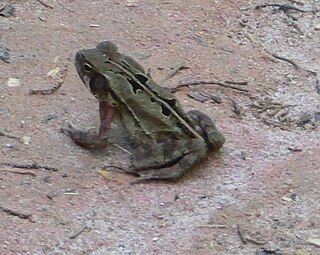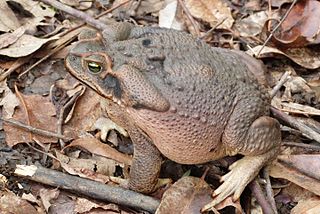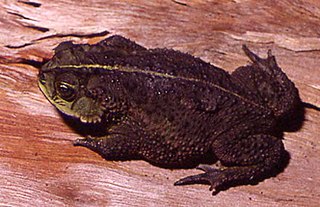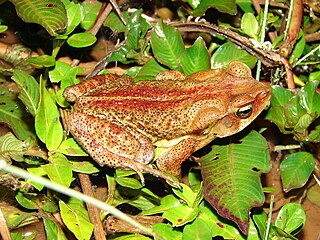
Rhinella achalensis is a species of toad in the family Bufonidae that is endemic to northern Argentina.
Rhinella amboroensis is a species of toad in the family Bufonidae that is endemic to the region of its type locality in the Carrasco Province of Bolivia and the adjacent Santa Cruz Department. Its common name is Cochabamba toad. It may exist in the Carrasco National Park and/or Amboró National Park, depending on its exact range.
Rhinella bergi is a species of toads in the family Bufonidae that is found in Argentina, Brazil, and Paraguay. Its natural habitats are dry savanna, moist savanna, subtropical or tropical seasonally wet or flooded lowland grassland, freshwater marshes, intermittent freshwater marshes, arable land, pastureland, and ponds. It is threatened by habitat loss.

Rhinella crucifer is a species of toad in the family Bufonidae. It endemic to Brazil and known from the Atlantic Forest of eastern Brazil between the states of Ceará in the north and Rio de Janeiro in the south. Common name striped toad has been coined for it. "Rhinella pombali" is a hybrid between Rhinella ornata and this species.

Rhinella diptycha, sometimes referred to as Cope's toad, Schneider's toad, cururu toad, or rococo toad, is a toad found in northern Argentina, Paraguay, Uruguay, eastern Bolivia, and eastern and southern Brazil. It is one of three rather similar species sometimes referred to as "cururu toads" in Brazil, the others being R. jimi and R. marina. Like those, R. diptycha is a large toad, females up to 25 cm (9.8 in) in snout–to–vent length and males up to 18 cm (7.1 in).

Rhinella fernandezae is a species of toad in the family Bufonidae that is found in Argentina, Brazil, Paraguay, and Uruguay. Its natural habitats are subtropical or tropical dry lowland grassland, subtropical or tropical seasonally wet or flooded lowland grassland, intermittent freshwater marshes, coastal freshwater lagoons, arable land, pastureland, plantations, and seasonally flooded agricultural land.
Rhinella gallardoi is a species of toad in the family Bufonidae that is endemic to Argentina. Its natural habitat is temperate forests. It is threatened by habitat loss.
Rhinella gnustae is a species of toad in the family Bufonidae that is endemic to Argentina. Its natural habitat is rivers. It is threatened by habitat loss.

Rhinella granulosa, also known as granular toad and common lesser toad, is a species of toad in the family Bufonidae. The species was redelimited in 2009 and is now considered endemic to Brazil.
Rhinella henseli is a species of toad in the family Bufonidae that is endemic to Brazil. Its natural habitats are subtropical or tropical moist lowland forests, rivers, and intermittent freshwater marshes. It is threatened by habitat loss.
Rhinella multiverrucosa is a species of toad in the family Bufonidae. It is endemic to Peru. Its natural habitat is subtropical or tropical moist montane forests. It is threatened by habitat loss.
Rhinella nesiotes is a species of toad in the family Bufonidae that is endemic to Peru. Its natural habitats are subtropical or tropical moist lowland forests and subtropical or tropical moist montane forests. It is threatened by habitat loss.

Rhinella ornata is a species of toad in the family Bufonidae that is found in Brazil and possibly Argentina. Its natural habitats are subtropical or tropical moist lowland forests, rivers, and intermittent freshwater lakes. It is threatened by habitat loss.
Rhinella pygmaea is a species of toad in the family Bufonidae. It is endemic to Brazil. Its natural habitats are subtropical or tropical moist lowland forests, subtropical or tropical moist shrubland, freshwater marshes, intermittent freshwater marshes, rural gardens, urban areas, and ponds. It is threatened by habitat loss.
Rhinella rubropunctata is a species of toad in the family Bufonidae that is found in southern Chile and Argentina. Its natural habitats are humid to xeric temperate forests and open environments. It tolerates a certain degree of disturbance. Breeding takes place in shallow temporary ponds near rivers, reservoirs and lakes. It is threatened by habitat degradation and fragmentation.
Rhinella rumbolli is a species of toad in the family Bufonidae that is found in Argentina and possibly Bolivia. Its natural habitats are temperate forests and rivers. It is threatened by habitat loss.
Rhinella veraguensis is a species of toad in the family Bufonidae. It is found in the Amazonian versant of the Andes and in the inter-Andean valleys in Bolivia and southeastern Peru. Its natural habitats are montane tropical forests and cloud forests. Breeding takes place in streams. There are no major threats to this common species, although it can locally suffer from habitat loss.
Rhinella festae is a species of toad in the family Bufonidae. It is found in Ecuador and Peru. Its natural habitats are subtropical or tropical moist lowland forests and subtropical or tropical moist montane forests. It is threatened by habitat loss.
Rhinella tenrec is a species of toad in the family Bufonidae. It is endemic to Colombia. Its natural habitat is subtropical or tropical moist lowland forests. It is threatened by habitat loss.

Rhinella achavali is a species of toads in the family Bufonidae that is found in Uruguay and southernmost Brazil.








